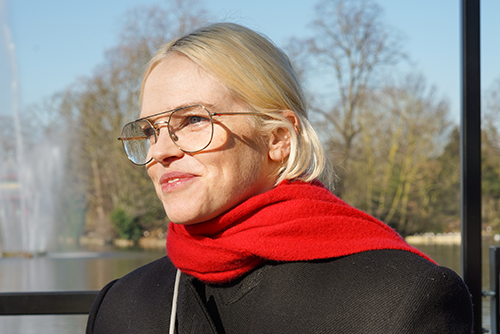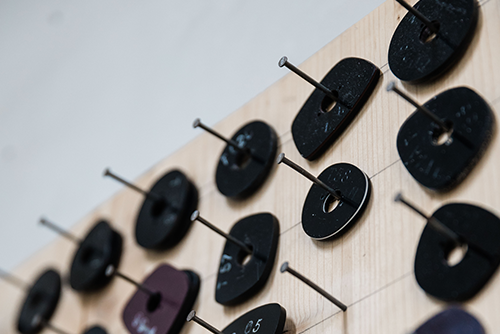Lydia Bolton, In The Frame
For those who might not know you, please can you tell us a bit about yourself?
I'm Lydia Bolton, a slow fashion designer and sustainability creator. I remake secondhand textiles and give them a new life. I do this through workshops, remaking products, and creative partnerships where I work with brands to reduce their textile waste.

In 2019 you founded your namesake sustainable fashion brand, Lydia Bolton. Starting an independent business is no small feat. Can you tell us what inspired you to take this path?
So I'd been working as a design assistant for a couple of years, and in my personal life I was really interested in sustainability, trying to live as sustainably as possible, and I heard this quote — ‘as a designer, you have a responsibility with what you create’ — and it just really struck me, and I thought if I'm passionate and really care about sustainability in my personal life, does it make sense that my career doesn't align with this? It made me think about the weight of what a designer is and how important it is that you can design and create things in a way that is better for the planet. So I decided to quit my job and slowly build up my brand which was centred around reusing. I probably went into it slightly naive, I just quit my job to work out what I would do within sustainability. I didn't actually know how it would evolve, and I think that unknownness helped!

After graduating from Kingston University with a first in Fashion Design, you continued your studies at UAL’s Centre for Sustainable Fashion. How did this further influence your approach to design?
Once I quit my job, I did this online course at CSM Center for Sustainable Fashion, and it was kind of the starting point of my brand and my work because during this course I learned all about the vast issue of textile waste, and I could see quite clearly how my skills as a designer and maker could create a small solution to this waste.
Your creations are often one-of-a-kind pieces made using waste fabrics or deadstock materials. How does this impact your design process? Do you find yourself designing based on what materials you find, or do you search for materials to bring a predetermined vision to life?
When you're working with secondhand and deadstock materials, the design process is quite different from traditional design, because you know you're gonna be restricted by colours and fabrics, it's all about what you can find and what's available, so I work in quite a different way. I can't be too prescribed with what I'm looking for. I always start by sourcing materials, I see what's available and then using those materials, I let them inform what I'm gonna be designing, exploring how I think they could work together in an interesting way. If I'm patchworking them, there are ways that I can mix certain fabrics together to make it like really exciting. I can link different colours within the pieces to make them flow together, or I can think of a general theme and then source materials within that theme. Last year, I did, a drop of summer shirts, and they all have a food theme on them. So I sourced a lot of tea towels and tablecloths.

What has been your favourite up-cycled creation so far?
This is a very tough one, I feel like it'd be choosing a child because I love them all! I did some up-cycled jumpers for Lidl and By Rotation a few Christmases ago, and those three jumpers were probably some of my favourites because it combined two of my favourite things, practicality and maximalism. One had tasseled sleeves, one had bows all over it, one was heavily embellished with sequins and crystals and beads.


In recent years it seems as though up-cycling workshops have become a key pillar of your brand mission. Why is this important to you and what do you hope to achieve with these workshops?
Workshops and skill sharing has become a really key part in my design practice and my brand. I started doing social distancing kits in lockdowns, these were little DIY kits to help people be creative and learn how to make things during lockdown, and from that it just evolved into this big part of my business. Skill sharing and helping other people feel capable and inspired to remake their own wardrobe and see potential in waste textiles for themselves, is just really important to me, and I think it fits my brand's mission — helping everyone see the value in things and giving them practical skills that they can use to do it themselves.

You’ve collaborated a with a number of independent and household brands, all with varyingly different levels of sustainability credentials - from Nike to Manchester United, and How do you navigate these partnerships and what’s your main goal going into them?
With partnerships, the main thing is that I'm meeting brands where they're currently at, and I'm helping provide a solution of textile reuse. Individuals and brands are all at different stages of their sustainable journey, and for me, helping people feel connected and included in this journey is really important. I do some of my workshops in shopping centres, which are often places that don’t go hand-in-hand sustainable, but it's really great to meet people who aren't very far down their sustainability journey yet and help them feel that it’s more accessible. Showing them that certain habits they have are already sustainable, and helping them feel encouraged and empowered to be more conscious with their decisions and choices as opposed to people feeling like sustainability isn’t for them for whatever reason. Doing workshops in these spaces is like breaking out of the sustainability echo chamber.
Can you tell us what has been your favourite collaboration to date and why?
My favourite collaboration is probably the one that I did with Lime. It was just such a fun project to do for lots of different reasons. It was called the Recycle collection, and we used waste clothing from Trade. The collection broke down the barriers for why people might not want to cycle. So I was also doing solution focused design and designing pieces that people would want to wear not just on the journey of the cycle ride, but then either be happy to wear post-cycle or able to fold up and pack away easily to make it as convenient for them as possible.

In your opinion, what steps could the fashion industry take to address the issue of overproduction and waste?
There are so many things that the fashion industry can do to combat overproduction. There's waste at every single stage within fashion, particularly within the producing of the materials. That's when the most carbon is produced, so that also shows why reuse and valuing what you already have is so important, because 70% of the carbon comes from the manufacturing of the materials and of the clothing.
I think with so much of fashion, particularly high street fashion and fast fashion, the margins are based off overproduction, and they know that X amount of it is always going go into the sale, and then another X amount of it is going to go into further sale or even go to outlets, and that's obviously a bad model to base production on, and really, things need to be produced to be sold at their initial price. Producing in a way that considers the planet, where it’s not just profit first.
Really, I think the whole system needs to collapse and everything be done differently, but it’s unlikely!
What advice would you give to consumers who wish to incorporate sustainability into their fashion practices?
I would say the most important thing is to really consider your purchases. Impulse shopping and buying things that you think you might like, but you're not actually sure you’d wear is a problematic way to shop. The key is to buy things that you really love, really want to wear, and keep in your wardrobe for a really long time. And if you're buying things that you really love, you'll then want to look after them and buy less, because you don't need five pairs of jeans if you have one or two amazing pairs.

Last but not least, just for fun, we always ask each ‘In The Frame’ participant which three people you'd invite to a dinner party? They can be from the past, present or even fictional.
OK, Michelle Obama, because I read her book, Becoming, and I loved it, she’s amazing. I also love The Royal Housewives, so I would have to throw a housewife in there, maybe someone like Sonia, she'll bring the party from New York, or maybe Lisa Vanderpump and we could have it at Villa Rosa. And for my third guest, I think I'd have Vivian Westwood because she's just so cool. A huge pioneer in sustainability and fashion activism, she'd give good advice and really help motivate us all to do better.
Lydia Bolton wears the Raval Spectacles in Quartz



